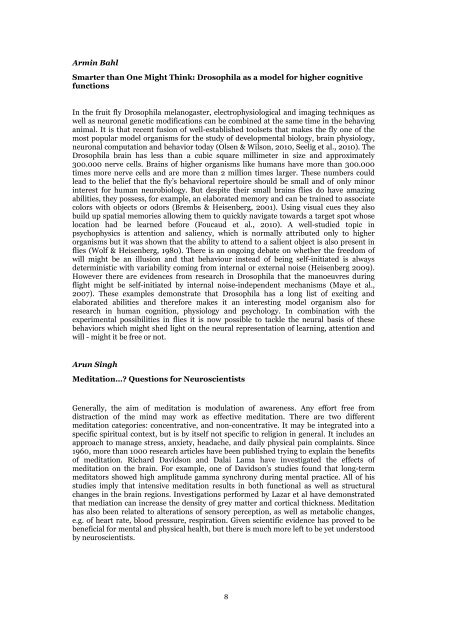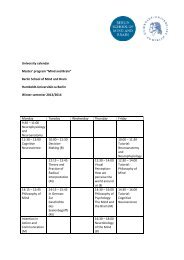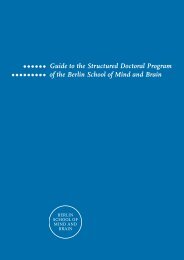Download - Berlin School of Mind and Brain
Download - Berlin School of Mind and Brain
Download - Berlin School of Mind and Brain
You also want an ePaper? Increase the reach of your titles
YUMPU automatically turns print PDFs into web optimized ePapers that Google loves.
Armin Bahl<br />
Smarter than One Might Think: Drosophila as a model for higher cognitive<br />
functions<br />
In the fruit fly Drosophila melanogaster, electrophysiological <strong>and</strong> imaging techniques as<br />
well as neuronal genetic modifications can be combined at the same time in the behaving<br />
animal. It is that recent fusion <strong>of</strong> well-established toolsets that makes the fly one <strong>of</strong> the<br />
most popular model organisms for the study <strong>of</strong> developmental biology, brain physiology,<br />
neuronal computation <strong>and</strong> behavior today (Olsen & Wilson, 2010, Seelig et al., 2010). The<br />
Drosophila brain has less than a cubic square millimeter in size <strong>and</strong> approximately<br />
300.000 nerve cells. <strong>Brain</strong>s <strong>of</strong> higher organisms like humans have more than 300.000<br />
times more nerve cells <strong>and</strong> are more than 2 million times larger. These numbers could<br />
lead to the belief that the fly’s behavioral repertoire should be small <strong>and</strong> <strong>of</strong> only minor<br />
interest for human neurobiology. But despite their small brains flies do have amazing<br />
abilities, they possess, for example, an elaborated memory <strong>and</strong> can be trained to associate<br />
colors with objects or odors (Brembs & Heisenberg, 2001). Using visual cues they also<br />
build up spatial memories allowing them to quickly navigate towards a target spot whose<br />
location had be learned before (Foucaud et al., 2010). A well-studied topic in<br />
psychophysics is attention <strong>and</strong> saliency, which is normally attributed only to higher<br />
organisms but it was shown that the ability to attend to a salient object is also present in<br />
flies (Wolf & Heisenberg, 1980). There is an ongoing debate on whether the freedom <strong>of</strong><br />
will might be an illusion <strong>and</strong> that behaviour instead <strong>of</strong> being self-initiated is always<br />
deterministic with variability coming from internal or external noise (Heisenberg 2009).<br />
However there are evidences from research in Drosophila that the manoeuvres during<br />
flight might be self-initiated by internal noise-independent mechanisms (Maye et al.,<br />
2007). These examples demonstrate that Drosophila has a long list <strong>of</strong> exciting <strong>and</strong><br />
elaborated abilities <strong>and</strong> therefore makes it an interesting model organism also for<br />
research in human cognition, physiology <strong>and</strong> psychology. In combination with the<br />
experimental possibilities in flies it is now possible to tackle the neural basis <strong>of</strong> these<br />
behaviors which might shed light on the neural representation <strong>of</strong> learning, attention <strong>and</strong><br />
will - might it be free or not.<br />
Arun Singh<br />
Meditation…? Questions for Neuroscientists<br />
Generally, the aim <strong>of</strong> meditation is modulation <strong>of</strong> awareness. Any effort free from<br />
distraction <strong>of</strong> the mind may work as effective meditation. There are two different<br />
meditation categories: concentrative, <strong>and</strong> non-concentrative. It may be integrated into a<br />
specific spiritual context, but is by itself not specific to religion in general. It includes an<br />
approach to manage stress, anxiety, headache, <strong>and</strong> daily physical pain complaints. Since<br />
1960, more than 1000 research articles have been published trying to explain the benefits<br />
<strong>of</strong> meditation. Richard Davidson <strong>and</strong> Dalai Lama have investigated the effects <strong>of</strong><br />
meditation on the brain. For example, one <strong>of</strong> Davidson’s studies found that long-term<br />
meditators showed high amplitude gamma synchrony during mental practice. All <strong>of</strong> his<br />
studies imply that intensive meditation results in both functional as well as structural<br />
changes in the brain regions. Investigations performed by Lazar et al have demonstrated<br />
that mediation can increase the density <strong>of</strong> grey matter <strong>and</strong> cortical thickness. Meditation<br />
has also been related to alterations <strong>of</strong> sensory perception, as well as metabolic changes,<br />
e.g. <strong>of</strong> heart rate, blood pressure, respiration. Given scientific evidence has proved to be<br />
beneficial for mental <strong>and</strong> physical health, but there is much more left to be yet understood<br />
by neuroscientists.<br />
8





